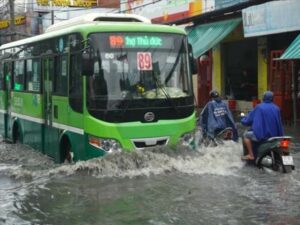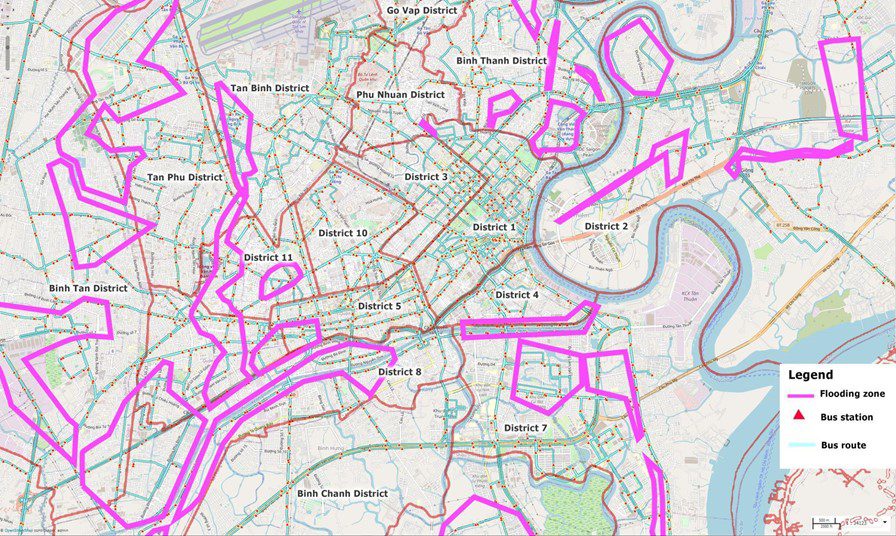Like many coastal countries, Vietnam is already feeling the impacts of rising sea levels and intense storms brought on by climate change. Its location in the Mekong Delta and surrounding the Saigon River makes Ho Chi Minh City (HCMC) prone to severe flooding. Overflowing canals during heavy rainfall can create a paralysis in the transport system and damage infrastructure, impacting the city’s estimated nine million residents.
When already congested roadways come to a standstill during such rains, the bus network that comprises the public transport system comes to a halt; ensuring a continuation of its services is key to keeping traffic running smoothly. While officials in Vietnam work toward improving drainage, building dams and levees, and enhancing green infrastructure, TUMI Labs is supporting them undertake a modelling and analysis to help mitigate this traffic congestion and find solutions to issues with the bus transport system during flooding.
While ownership of the project lies with the HCMC Department of Transportation, the Vietnam-German University (VGU) is leading the work by providing their technical expertise and engaging with the relevant stakeholders to develop a data framework for measuring disruptions in real time.
In a first step toward mitigating the effects of such severe weather, TUMI Labs plans to develop a model that can better predict congestion due to flooding events. Collecting data and analyzing it with the use of algorithms will provide valuable insights to officials in Vietnam who can work to adapt to the future, climate proofing roadways to ensure continued operations. The main goal is to prototype solutions that can relieve the congestion for the nearly 2,084 private and public operated buses that travel along some 127 bus routes.
Among the data already available for collection is an extensive GPS network, thousands of camera feeds that track traffic flow and accidents throughout the city, weather data, congestion reports, traffic violations, and e-payment systems. Using the information gathered, VGU is creating an algorithm to curtail transport delays by adapting the bus routes in real time. As the impacts of climate change become more severe, the city can also use these insights on other extreme weather events and to implement further flood protection infrastructure.

Influence of flooding on bus operation. Source: Lao dong Newspaper
Gaining such insights will help HCMC in achieving the goals of its sustainable mobility plan, getting more people onto public transport and making their commutes run faster and more smoothly. At the moment, a bus company estimates that 5 of their 20 bus routes are prone to road congestion — particularly on the line #27 during rush hour. Due to a lack of traffic prediction tools for assisting bus operation management systems, many passengers cannot use the bus routes and have long waits at the affected bus stops when sudden road congestion arises. At the same time, the company cannot reroute the affected bus routes until they have sent two buses to the congestion point to prove the event in order to get an approval for rerouting. Automated congestion prediction and rerouting processes based on the big data approach and machine learning algorithms could help alleviate these issues for the bus companies.
At the same time, the city understands it needs to improve its public transport system, which currently only covers around 7% of the modal split. Overcrowding and delays may prevent more people from taking advantage of this efficient form of travel so expanding the bus network will help to cover more ground. Yet creating dedicated bus lanes is difficult due to the city’s topography and narrow streets — issues the city is currently looking into with TUMI Labs’ support.
It isn’t the first cooperation between TUMI and Vietnamese officials. In 2018, the TUMI Challenge worked with the city of Hoi An to build out a bicycle sharing system and a cycling infrastructure that includes a bike path. Though their implementation was seriously impacted by the COVID-19 pandemic and a drop in tourism, the success of the project is cemented in the continued use of the infrastructure along with an unrelenting commitment to reducing car and motorcycle use in favor of bicycles as a viable means of transport.
